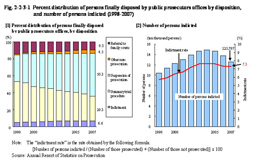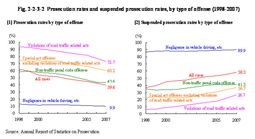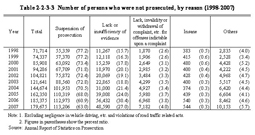| Previous Next Index Image Index Year Selection | |
|
|
Fig. 2-2-3-1 shows the trends in percent distribution of persons prosecuted or not prosecuted and the number of persons indicted in the last 10 years. In 2007, the total number of persons finally disposed was 1,905,951. The number of persons indicted was 125,787 (6.6% of the total), the number of those who were prosecuted for summary trial procedure was 558,696 (29.3%), the number of those who were granted suspension of prosecution was 957,907 (50.3%), the number of those not prosecuted for other reasons was 85,955 (4.5%), and the number of those referred to family courts was 177,606 (9.3%). The number of persons indicted increased every year after 1995, but turned to decrease in 2005, and it also decreased by 12,242 from the previous year in 2007 (see Appendix 2-2). Fig. 2-2-3-1 Percent distribution of persons finally disposed by public prosecutors offices by disposition, and number of persons indicted (1998–2007) Fig. 2-2-3-2 shows the trends (over the last 10 years) in the prosecution rate and the suspended prosecution rate of those finally disposed by the prosecutors office by type of offense (see Appendix 2-3).Fig. 2-2-3-2 Prosecution rates and suspended prosecution rates, by type of offense (1998–2007) Table 2-2-3-3 shows the number of persons not prosecuted (over the last 10 years), by reason (excluding negligence in vehicle driving, etc. and violations of road traffic related acts).In 2007, the rate of those not prosecuted due to suspension of prosecution fell by about 14 points from 1998, while the rate of those not prosecuted due to “lack or insufficiency of evidence” rose by about 11 points. Table 2-2-3-3 Number of persons who were not prosecuted, by reason (1998–2007) |


